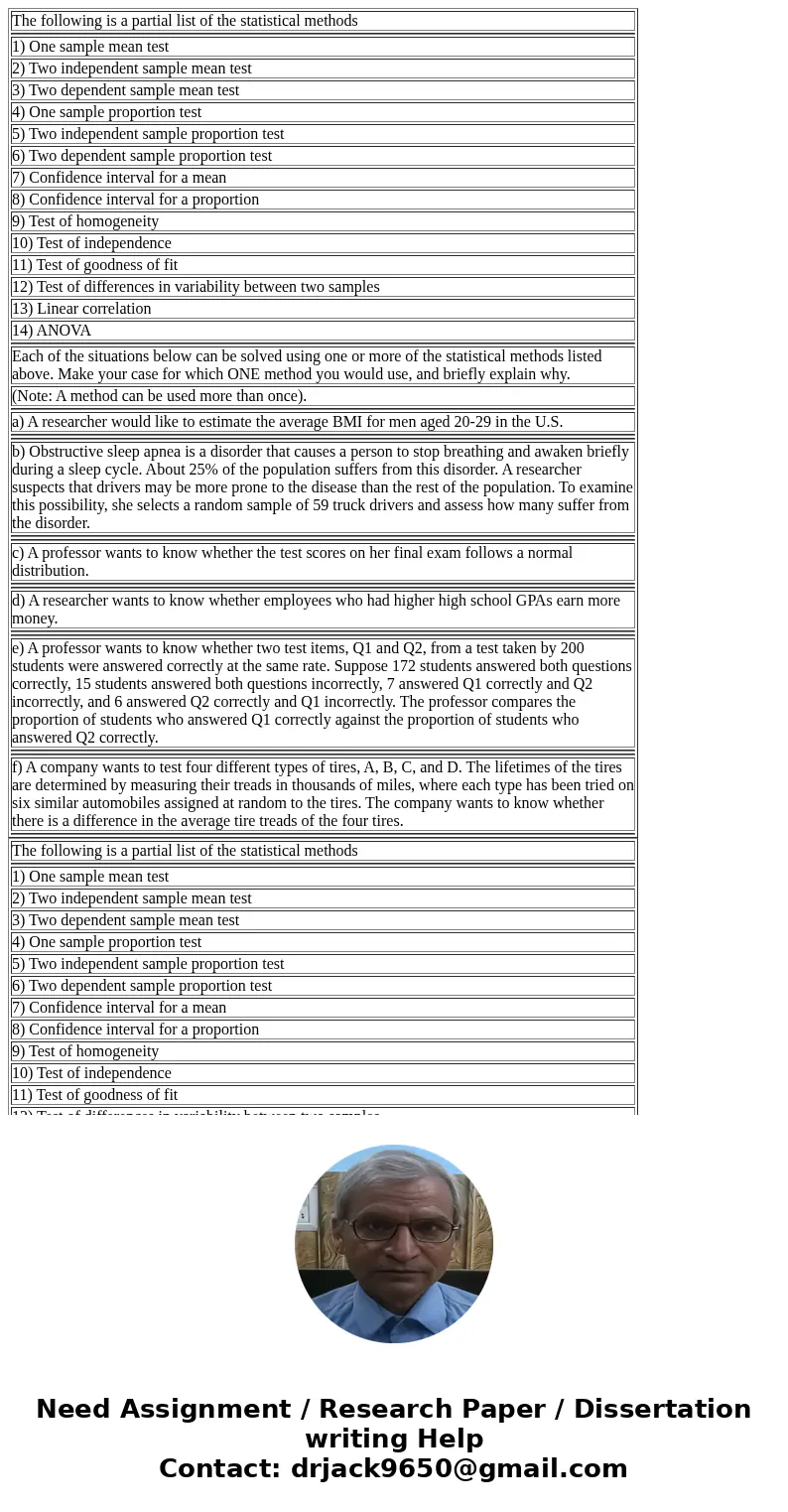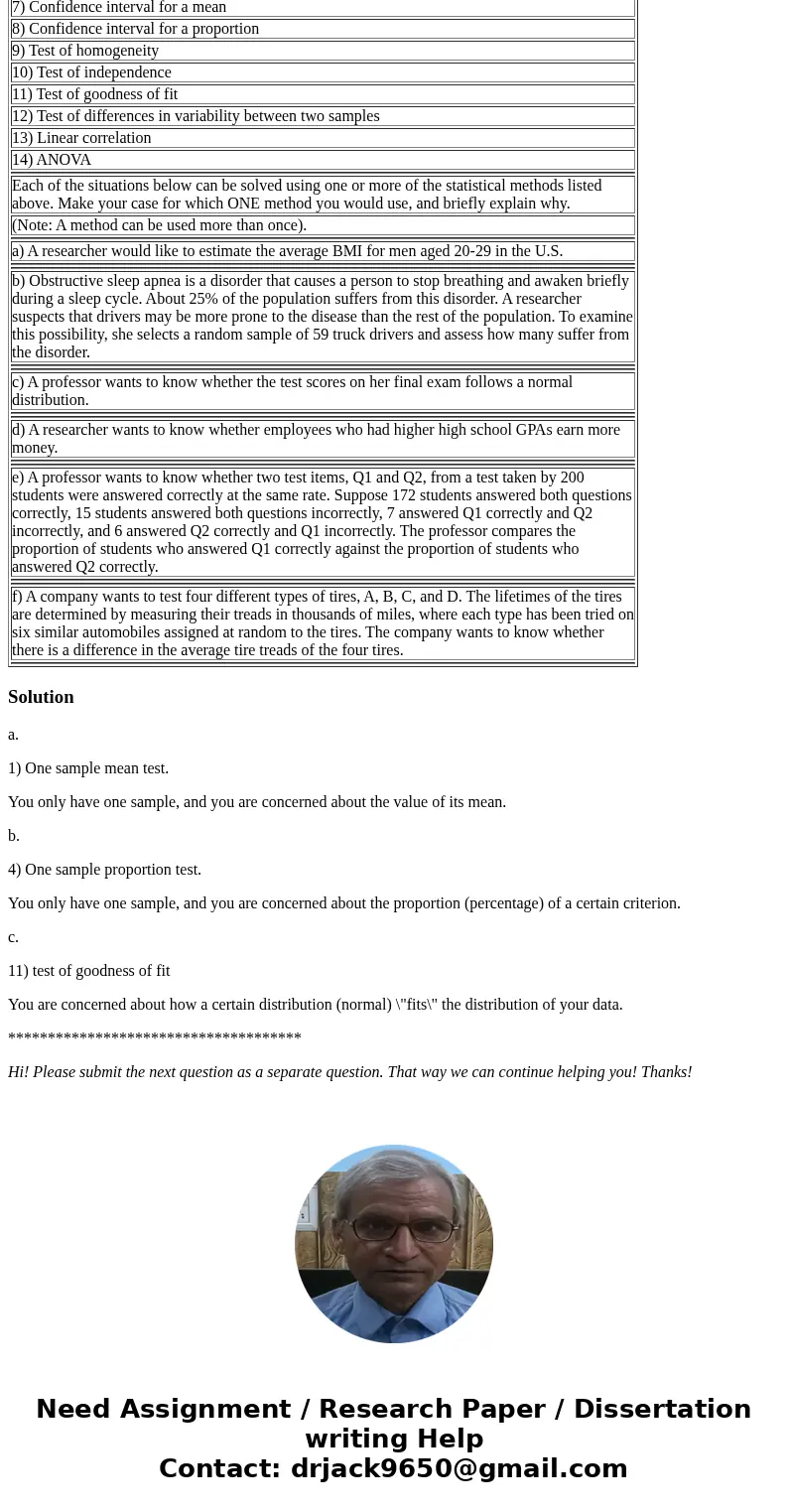The following is a partial list of the statistical methods 1
| The following is a partial list of the statistical methods |
| 1) One sample mean test |
| 2) Two independent sample mean test |
| 3) Two dependent sample mean test |
| 4) One sample proportion test |
| 5) Two independent sample proportion test |
| 6) Two dependent sample proportion test |
| 7) Confidence interval for a mean |
| 8) Confidence interval for a proportion |
| 9) Test of homogeneity |
| 10) Test of independence |
| 11) Test of goodness of fit |
| 12) Test of differences in variability between two samples |
| 13) Linear correlation |
| 14) ANOVA |
| Each of the situations below can be solved using one or more of the statistical methods listed above. Make your case for which ONE method you would use, and briefly explain why. |
| (Note: A method can be used more than once). |
| a) A researcher would like to estimate the average BMI for men aged 20-29 in the U.S. |
| b) Obstructive sleep apnea is a disorder that causes a person to stop breathing and awaken briefly during a sleep cycle. About 25% of the population suffers from this disorder. A researcher suspects that drivers may be more prone to the disease than the rest of the population. To examine this possibility, she selects a random sample of 59 truck drivers and assess how many suffer from the disorder. |
| c) A professor wants to know whether the test scores on her final exam follows a normal distribution. |
| d) A researcher wants to know whether employees who had higher high school GPAs earn more money. |
| e) A professor wants to know whether two test items, Q1 and Q2, from a test taken by 200 students were answered correctly at the same rate. Suppose 172 students answered both questions correctly, 15 students answered both questions incorrectly, 7 answered Q1 correctly and Q2 incorrectly, and 6 answered Q2 correctly and Q1 incorrectly. The professor compares the proportion of students who answered Q1 correctly against the proportion of students who answered Q2 correctly. |
| f) A company wants to test four different types of tires, A, B, C, and D. The lifetimes of the tires are determined by measuring their treads in thousands of miles, where each type has been tried on six similar automobiles assigned at random to the tires. The company wants to know whether there is a difference in the average tire treads of the four tires. |
| The following is a partial list of the statistical methods |
| 1) One sample mean test |
| 2) Two independent sample mean test |
| 3) Two dependent sample mean test |
| 4) One sample proportion test |
| 5) Two independent sample proportion test |
| 6) Two dependent sample proportion test |
| 7) Confidence interval for a mean |
| 8) Confidence interval for a proportion |
| 9) Test of homogeneity |
| 10) Test of independence |
| 11) Test of goodness of fit |
| 12) Test of differences in variability between two samples |
| 13) Linear correlation |
| 14) ANOVA |
| Each of the situations below can be solved using one or more of the statistical methods listed above. Make your case for which ONE method you would use, and briefly explain why. |
| (Note: A method can be used more than once). |
| a) A researcher would like to estimate the average BMI for men aged 20-29 in the U.S. |
| b) Obstructive sleep apnea is a disorder that causes a person to stop breathing and awaken briefly during a sleep cycle. About 25% of the population suffers from this disorder. A researcher suspects that drivers may be more prone to the disease than the rest of the population. To examine this possibility, she selects a random sample of 59 truck drivers and assess how many suffer from the disorder. |
| c) A professor wants to know whether the test scores on her final exam follows a normal distribution. |
| d) A researcher wants to know whether employees who had higher high school GPAs earn more money. |
| e) A professor wants to know whether two test items, Q1 and Q2, from a test taken by 200 students were answered correctly at the same rate. Suppose 172 students answered both questions correctly, 15 students answered both questions incorrectly, 7 answered Q1 correctly and Q2 incorrectly, and 6 answered Q2 correctly and Q1 incorrectly. The professor compares the proportion of students who answered Q1 correctly against the proportion of students who answered Q2 correctly. |
| f) A company wants to test four different types of tires, A, B, C, and D. The lifetimes of the tires are determined by measuring their treads in thousands of miles, where each type has been tried on six similar automobiles assigned at random to the tires. The company wants to know whether there is a difference in the average tire treads of the four tires. |
Solution
a.
1) One sample mean test.
You only have one sample, and you are concerned about the value of its mean.
b.
4) One sample proportion test.
You only have one sample, and you are concerned about the proportion (percentage) of a certain criterion.
c.
11) test of goodness of fit
You are concerned about how a certain distribution (normal) \"fits\" the distribution of your data.
*************************************
Hi! Please submit the next question as a separate question. That way we can continue helping you! Thanks!


 Homework Sourse
Homework Sourse